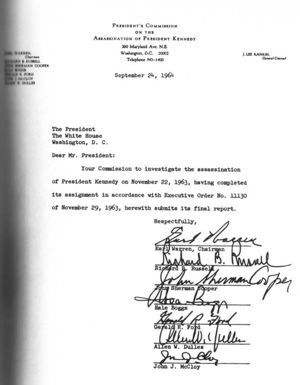Warren Commission
 | |
| Date | 29 November 1963 - 24 September 1964 |
|---|---|
| Interest of | Walt Brown |
| Interests | JFK/Assassination |
| Description | A "Presidential Commission of unimpeachable personnel" (in the words of Nicholas Katzenbach) convened to "head off public speculation [about the JFK assassination] or congressional hearings of the wrong sort." |
| Participants | Earl Warren, Richard Russell, John Sherman Cooper, Hale Boggs, Gerald Ford, Allen Dulles, John J. McCloy |
The Warren Commission was convened by the JFK/Assassination/Perpetrators in an attempt to cover up the truth of the JFK assassination by promoting the FBI's claim that it was done by "lone nut", the late Lee Harvey Oswald.
Contents
Origins
After the assassination Lyndon B. Johnson appointed the commission to investigate and told commissioner Earl Warren that they must find Lee Harvey Oswald as the lone assassin. Warren was originally unwilling, but was blackmailed into lending his name to the commission.[citation needed] US Deputy Attorney General, Nicholas Katzenbach wrote that "The public must be satisfied that Oswald was the assassin; that he did not have confederates who are still at large".[1]
Parallels
The "conclusion first, then evidence" approach was followed by Philip Zelikow, who headed up the 9/11 Commission and had already structured the report and conclusions before seeing any the evidence.
Failure to investigate
The commission did not interview witnesses such as Eugene Dinkin whose testimony didn't fit the FBI's "Oswald acted alone" story.
Conclusion
The Warren Commission concluded that Oswald acted alone and that no credible evidence supported the contention that he was involved in a conspiracy to assassinate the president.[2] According to the Warren report, Oswald fired three shots in six seconds to kill the president (although leaving four bullets and, without leaving any residue of nitrate on his cheek). They also concluded that one of the bullets managed to cause seven entry/exit wounds penetrating 15 inches of tissue, 4 inches of rib and a radius bone to come out in almost perfect condition. These results have never been duplicated. [3]
Scepticism
Governor John Connally
"I do not for one second believe the conclusions of the Warren Commission."
Robert F. Kennedy
"The Warren Commission was a shoddy piece of craftsmanship."
Robert F. Kennedy JR.
"The evidence at this point I think is very, very convincing that it was not a lone gunman."
Related Quotation
| Page | Quote | Author | Date |
|---|---|---|---|
| Hale Boggs | “This is somewhat like the position the Warren Commission took when Richard Russell, Hale Boggs and John Sherman Cooper refused to sign the draft of the Warren Report until a qualifying statement was inserted. The statement read, ‘Because of the difficulty of proving negatives to a certainty the possibility of others being involved with either Oswald or Ruby cannot be established categorically but if there is any such evidence it has been beyond the reach of all the investigative agencies and resources of the United States and has not come to the attention of this Commission.’” | Hale Boggs Richard E. Sprague | 1985 |
Employee on Wikispooks
| Employee | Job | Appointed | End | Description |
|---|---|---|---|---|
| Albert E. Jenner | Assistant counsel | 1963 | 1964 | "a curious choice for the commission staff" |
Known Participants
All 7 of the participants already have pages here:
| Participant | Description |
|---|---|
| Hale Boggs | A US House Majority Leader who strongly dissented from the official narrative of the JFK Assassination. His small plane disappeared without trace in Alaska, together with Nick Begich and two other men. |
| John Sherman Cooper | US lawyer who refused to sign the draft of the Warren Commission Report until a qualifying statement was inserted. |
| Allen Dulles | Dulles served the longest ever term as Director of Central Intelligence and dominated American intelligence for a generation. He personified a cadre of Ivy League pragmatic elitists in high echelons of the government who greatly admired Germany’s scientific achievements.<a href="#cite_note-1">[1]</a> Dulles was fired by JFK after the Bay of Pigs and bore a grudge against him thereafter. |
| Gerald Ford | US Deep State functionary who was made US President by The Cabal after they removed Richard Nixon with the Watergate Coup |
| John J. McCloy | US deep politician, Warren Commission, CFR Chair for 17 years, President of the World Bank ... |
| Richard Russell | |
| Earl Warren | US chief justice. Blackmailed to go along with The Cabal's Warren Commision cover up of the JFK assassination |